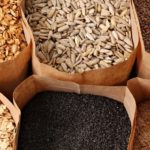In this newsletter issue we’re going to focus on that mysterious miracle grain, but before we do, let’s review quickly.
Cutting refined carbs and minimizing high glycemic grains and starchy vegetables from your diet makes all the sense in the world. Replacing those foods with large amounts of meat and dairy and artificial sweeteners does not – particularly since you can get all of the benefits associated with these diets without the negative side effects.
And how did we get lost in such craziness? Quite simply, we were once again seduced by our love of broad stroke generalizations.
- Generalization: Fat is bad. Specific: That’s wrong! It misses the distinction between good (essential) fats and bad fats.
- Generalization: Saturated fat is bad. Specific: Wrong again! The right kind of saturated fat is essential. Coconut oil, one of the most saturated fats in existence, is one of the healthiest fats you can eat.
- Generalization: Carbohydrates are bad. Specific: Strike three! There are good carbs and bad carbs and, in fact, some carbs are just plain essential. (By the way, kudos to Dr. Mercola, who avoids this trap by calling his diet the No Grain Diet. But as it turns out, even that statement, as specific as it first seems, is still too much of a generalization and misses the mark!)
A Grain Is Not Necessarily a Grain
Is wheat a grain? Of course, everyone would agree that wheat is a grain. Is wheat bad on a low carb diet? Again, wheat (even whole grain) is problematic on a low carb diet.
But what about wheat grass? Many people feel that the grass that grows the first few days after wheat sprouts is one of the healthiest foods on the planet. Is wheat grass a carbohydrate? Absolutely. Is it okay to eat on a low carb program?? Well, many people would say that as a grass, it’s more like a vegetable than a grain. An unusual definition of vegetable to be sure, but let’s go with it.
But what about a wheat berry sprout? What about sprouts in general? Are they carbs? Yes. Absolutely. Are they grains? Interesting question. At what point in the growing process does a grain become a plant?
And then there are “pre-sprouts.” Take oats. There’s a huge difference between rolled oats cooked in boiling water and whole oat groats put in a thermos overnight with hot water. Yes, they both taste just like warm oatmeal in the morning, but you can plant the puffed up “pre-sprouted” groats in the ground, and they will grow!! They haven’t sprouted yet, but the proteins and carbohydrates have been transformed. The pre-sprouted groats are still alive. They will grow. And yet they are not a plant. They are not sprouts. They are still grains, but they are transformed. They are a different animal, with remarkable properties. They are pre-sprouts.
Which brings us to the question at hand. What is the miracle grain that I have been hinting at over the last two newsletters?
It’s pre-sprouted barley.
Barley
Before we actually get into the details of Aktivated Barley, we need to look briefly at barley in general.
Research conducted in Canada, the United States, and Australia has shown that barley can play a significant role in lowering blood cholesterol in hypercholesterolemic subjects. Other studies have shown that non-insulin dependent diabetics (Type II) had improved blood glucose levels as a result of including barley in their diet. It should be noted that barley rates an astoundingly low 27 on the glycemic index. That’s 22 percent less than skim milk! And yet which one is banned form the low carb no grain diets?
In addition, barley has high concentrations of tocotrienols, antioxidant compounds that work to suppress the activity of the first rate-limiting enzyme (HMG-CoA Reductase) in the liver, thus reducing cholesterol synthesis. And barley is one of the highest known sources of beta-glucans, carbohydrates (there’s that word again) that have remarkable immune boosting properties and have been shown to improve blood glucose and lipid levels among diabetics in clinical trials.
Historically, barley has been used for thousands of years. The Roman army marched on it. It was the primary staple of their diet. They picked up that trick from the Greek gladiators who trained on it and were known as “barley eaters.” (So much for meat being the food of choice for macho men.)
In ancient Rome, a food made from spouted barley, honey, and colostrum was used to sustain infants whose mother’s had died in childbirth. In more recent years, the same formula has been used by the UN to prevent starvation in Third World countries.
Aktivated Barley
The problem with sprouted barley is that it’s extremely gelatinous. All attempts to dry it and package it for commercial distribution failed until a company in Sweden, called Nutritech International, figured out a way to use low-temperature steam (produced in a partial vacuum) to take the barley just up to the point of sprouting — before it turns gelatinous, but after the point where all the proteins and carbohydrates have been converted, and at a temperature low enough so that no enzymes are damaged.
This turns out to be a remarkably interesting point for food. It’s like the food is placed in a state of suspended animation at the point where all of the energy of the grain has been marshaled to sprout the pearl — and not yet expended in the act of sprouting.
The result is a brand new superfood with unbelievable properties. Think of it like a bullet in a gun.
- The bullet in the chamber is like the barley pearl. All the energy is dormant — unavailable.
- The bullet, after it has fired and left the gun, is like the barley sprout. All of the energy has been expended in the act of making the bullet shoot out of the gun — or in this case, making the barley sprout. The energy has been used up. It is no longer available.
- But pre-sprouted barley is different. It’s like being able to freeze time at the moment the gunpowder has fired and before the bullet has left the gun. A huge amount of energy is now locked in the chamber, available in an easily used form, just waiting to be directed in any way you want. What if you could take that energy and use it for other things rather than making the bullet fly? What if you could use the energy locked in the pre-sprout phase to nourish the body rather than make the barley sprout? That would be a true superfood.
And in fact, this Aktivated Barley produces some astounding numbers on the Bovis Scale.
If you are not familiar with the Bovis Scale, it was developed by a French physicist and quantifies or measures how positively or negatively charged a substance is. For living organisms, the key reference point on the scale is found at 6,500 Bovis Energy Units. From 0 to 6,500, the charge is in the negative range, or life-detracting, while above the 6,500 point the energy gradually becomes more positive, or life-enhancing.
The desired minimal energy level for humans is found between 8,000 to 10,000 Bovis Energy Units, or slightly positive. The Earth itself creates energy in the 7,000 to 18,000 range. This energy is also referred to as “Biophotons”, which are light particles invisible to our eyes. This positive radiation is necessary to the maintenance of life on Earth.
A simple way of describing Bovis Energy Units would be to call them “Bio-Photon-Activating” Energy Units.
Bottom line: This new pre-sprouted ultra-long-chain carbohydrate found in pre-sprouted barley registers 320,000 on the Bovis Scale. That is unheard of for food. The only thing I’ve ever seen higher than that is specially treated water.
Note: While the concept of the Bovis scale is based on sound theory, and the results on the body of the ingestion of high Bovis foods and water is clearly observable, accurate methods for measuring substances on the Bovis scale are in short supply. At this point in time, it is probably best to consider Bovis ratings as general indicators, rather than as accurately verifiable numbers.
The Properties of Aktivated Barely
- Like regular barley, it ranks incredibly low on the glycemic index.
- It has all of the nutritional value of barley — high levels of tocotrienols and beta glucans. In fact, pre-sprouting increases beta glucan levels by some 77% according to tests performed by AnalyCen in Sweden.
- It contains 1,000s of active enzymes.
- It is an ultra-long-chain carbohydrate that takes up to 4 hours to break down in the digestive tract — thus providing a slow, sustained release of energy and insulin.
- Because the release is so slow, it actually lowers the body’s insulin response.
- It provides over 400% more energy per calorie than any other food calorie known. (Despite what the FDA may tell you, not all calories are created equal.) As it turns out, there are two different ways to test for caloric value. The traditional way is by burning the product to determine the energy released. This is the FDA approved standard. However, a more meaningful test is to measure the metabolic calorie value — that is: how much energy the BODY can use or produce from the food in question. For Aktivated Barley, the metabolic calorie value is 400% higher than a standard calorie such as fat. Or to look at it another way, with Aktivated Barley you get the same energy on 1/4 the calories VS standard calories.
- It produces readings of up to 320,000 on the Bovis scale.
Bottom Line: Nutrition for health
Foods like Aktivated Barley put the lie to broad generalizations such as “avoid all carbs or grains.” Broad brush strokes, when it comes to diet and nutrition tend to be flawed almost by definition. As I have repeatedly said, common sense and balance are the keys to good diet. Don’t be swayed by the latest fad. Certainly eliminate as much as possible all sugars and refined carbohydrates from your diet. Cut way back on high glycemic foods. But don’t throw the baby out with the bathwater. Don’t replace them with high levels of protein, dairy, and artificial sweeteners. Do replace them with nutrient dense foods. And don’t ignore the good carbohydrates. They are essential for life.
And as for Aktivated Barley, I have been so impressed with it that I ended up totally redesigning a meal replacement shake that had been in testing for almost six months to take advantage of its remarkable properties. The shake is being released by Baseline Nutritionals®. I’m also using it in a superfood formula sold by the same company.
Keep your eyes open. Over the next 12 months, you’ll be seeing Aktivated Barley appearing in many different companies’ formulas. Something this good won’t stay secret for long.
Learn more about Natural Weight Loss
Low Carb Craziness, Part 1
Low Carb Craziness, Part 2
Or visit our Healthy Weight Loss Program.











I have really enjoyed reading
I have really enjoyed reading your other articles and have just signed up for your newsletter. But I was a bit disappointed with the general tone of this one. It sounds to me like you are getting paid to promote this Aktivated Barley. The whole vibe of this email was like reading Tony Robbins self help book or something, it has lost that factual flow, and instead uses a lot of words in bold, and exclamation marks. While I appreciate you may be genuinely excited about this product, it doesn’t sound very natural, in fact rather processed, and again I am actually put off by the way it is promoted. I hate to think that this is yet another American farce, as it seems like almost everything in your country is actually funded by some large corporation with only their wallets serving as the true motivation. (I am about to give up on even advice from others and move to the country and only grow my own vegetables…)
Sorry to disappoint you, but
Sorry to disappoint you, but if it’s a farce, it’s not American; it’s European. Aktivated barley comes exclusively from Sweden.
I was referring to your
I was referring to your promotion of it, not the actual product itself.
I would not be willing to
I would not be willing to consider this to be in any way similar to a Robbins self help presentation. Every time I hve read that learned discussions on any topic, I come away more knowledgeable and educated to how products/foods affect health. This is the case with teh aktivated barley. If I had discovered this product, I would be impossible – always talking about the amazing results, especially on cholestrol. I hope the DR continues righting such great advice for the layman!
A bit late in my
A bit late in my participation, but nevertheless..
The above promotion, is simply, and simply is the operative word here, a true “cut and paste” from the manufacturers and promoters of Activated Barley (among others Sunwarrior.com). Not a word has been changed or altered.. Try for yourselves. Copy a few lines, and google it.. Many hits…
Long live the lazy, free enterprize and capitalism.. I lived in the
US for 4 years.. Now I am reminded why I left..
But, Activated Barley is great. I buy it from the UK. For European customers this is waayyyy cheaper. It is grown in southern Sweden exquisitely.. Look to Scandinavia;-)
Jon Barron first wrote about
Jon Barron first wrote about Activated Barley in 2004 – before anybody else even knew that Activated Barley existed – in fact, before most of these companies even existed. Here’s the article he wrote in 2004 http://www.jonbarron.org/weight-loss/barron-report-natural-alternative-shake. So what you’re actually saying is that these other companies have cut and pasted Jon Barron’s copyrighted words onto their websites. We were aware of that, but thanks for noticing.
Can we pre-sprout barley at
Can we pre-sprout barley at home? Is it enough to just leave the barley groats soaked in warm water over night and eat them in the morning? What would be the optimal water temperature for for this process? Thanks
You can certainly sprout
You can certainly sprout barely, which would create pre-sprouted barley along the way. http://www.ehow.com/how_4454753_sprout-barley.html. The problem is stopping the process of sprouting at the pre-sprout point in such a way as to not destroy many of the nutrients. Heating, for example, could stop the process at the pre-sprout point but would also destroy many of the nutrients.
I don’t see how anyone, let
I don’t see how anyone, let alond someone who appears to be reasonably intelligent, can view dietary recommendations through anythign other than the lens of evolution. How much barley (or grains of any description) were we eating back when?
I vote very very few. hunter-gather theory of calorie-time efficiency